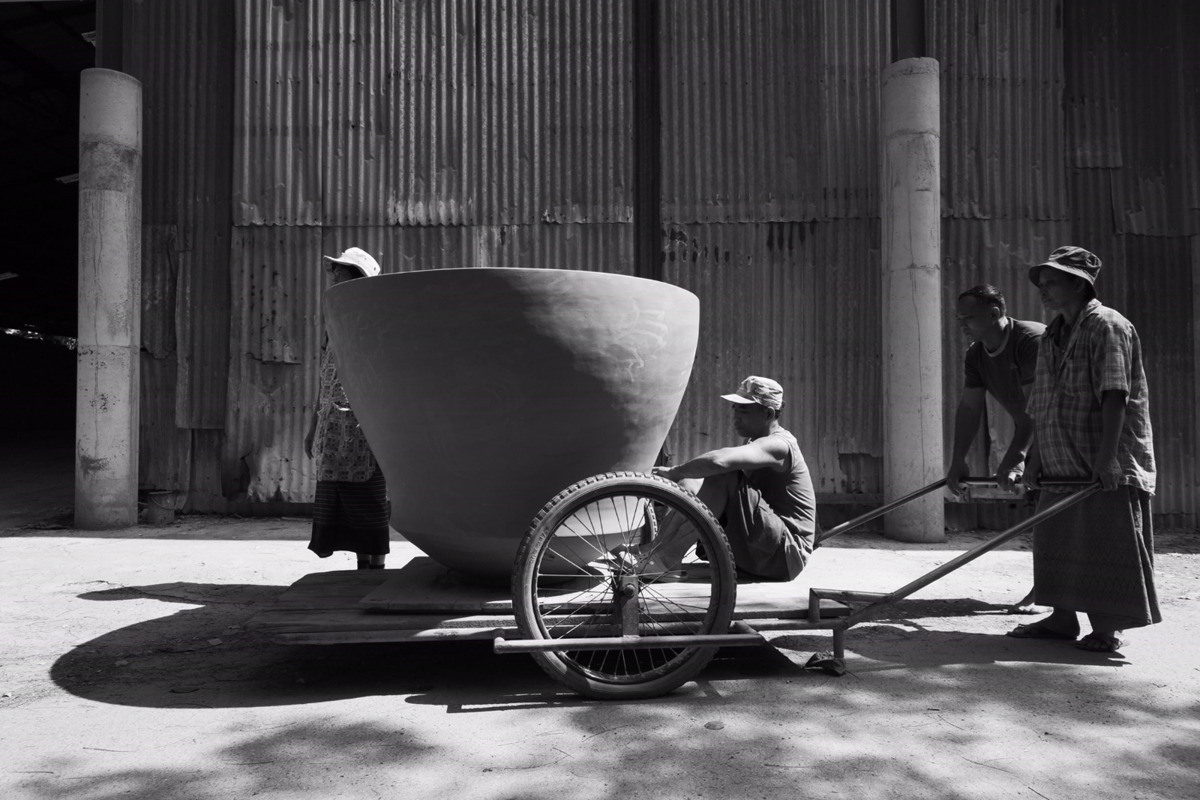A BERLIN – RATCHABURI DIALOGUE
By Stefanie Hering and Wasinburee Supanichvoraparch
Bangkok/Berlin 2019. On the initiative of Maren Niemeyer, head of the Goethe-Institute in Thailand, the BACC is exhibiting from 8 to 30 March 2019 a selection of artistic works by German porcelain designer Stefanie Hering and Thai photographer Wasinburee Supanichvoraparch in an extensive installation. The cultural dialogue encompasses Stefanie Hering’s own series of her hand-constructed porcelain vases and vessels, specially created for the showcase; the works are up to two metres in height, which is an absolute novelty in ceramic manufacturing. This series of art works, developed over the course of months and as spectacular as it is conscientious, could be realised only in the ceramic workshop of Wasinburee Supanichvoraparch in Ratchaburi. Here, Stefanie Hering found unique and still preserved manufacturing techniques for the implementation of her oversized objects. Wasinburee Supanichvoraparch captured the artistic manufacturing processes on-site in Thailand and also filmed in Stefanie Hering’s German workshop, where the first sketches came into being and the final touches were put to the porcelain editions. It is this film and photographic documentation that initially opens the eloquent dialogue between the two cultures to the viewers in all its sequences and invites them to examine their unique characteristics as well as the surprising similarities.
First exhibition venue: BACC 8-30 March 2019
Concept of the exhibition
Two cultures – ONE philosophy of pure craftsmanship. In March 2019, the presentation in the BACC kicks off an exhibition series which brings together Stefanie Hering’s porcelain works of art, handmade in Thailand and Germany, and the experimental documentation by film and photographic artist Wasinburee Supanichvoraparch. The viewer is taken on a cultural journey through time and place: Here is the elaborate, traditional cottage-industry manufacture that has been refined over hundreds of years and which is recognised today as being worthy of preservation, and there are the differences between the geographically separate cultures of Germany and Thailand – and last but not least, the clash between offline and online that is reflected in the ostensible contradiction between timeconsuming craftsmanship and its digital documentation and dissemination. The result? An inspiring field of tension that invites the observer to consider their own consumption and values.
Artistic idea of the series
Out of the function-aligned culture of vessels, Stefanie Hering creates objects which, through their explicit size and powerfully expressive handmade character, have a sculptural, statuesque quality. The function gives way to the absolute aesthetic of the form. Stefanie Hering develops the basic forms through construction and development in the Thai workshops. In Germany, these are translated into porcelain in Hering’s master workshop. The result is a completely new language of form for the “white clay”.
Manufacturing Processes
Stefanie Hering is a trained porcelain master and can rely in her artistic endeavours on her absolute knowledge of the medium of porcelain. She has now founded a studio in Thailand that has made it possible for her to realise her unique, oversized objects in giant ceramic ovens. And it was first in Thailand that she found the natural raw materials that enable the creation of such large-scale works. The collaboration with Thai artisans is described by the artist as extremely inspiring: “In Europe, the conditions to create this sort of large, handmade ceramic object are often lacking. Here in Thailand, I can experiment freely in workshops in which centuries- old craftsmanship meets pure joy of design. We will exhibit this happy combination and the results of my work in the exhibition with the Goethe-Institut.”
Artist Portraits
Stefanie Hering
Manufactum – the traces of the hand characterise every single object by Stefanie Hering. Her philosophy of pure craftsmanship creates sustainable, unique pieces of a high cultural value. This applies to her design collections, which are produced by craftsmen trained over many years, and in particular to her work as a freelance artist who realises each individual art object herself in all its stages. The special and inimitable features are Stefanie Hering’s consummate forms that spring from play, trial and experiment as well as from the absolute knowledge of the porcelain material. Stefanie Hering, herself a trained porcelain master, explores the boundaries of the feasible and in her artistic endeavours constantly goes beyond them (for example, with special porcelain formulas, glazes or firing processes), making her a visionary in the art of porcelain making.
Wasinburee Supanichvoraparch
Born in 1971, lives and works in Ratchaburi, Thailand. As a ceramic designer and artist, Wasinburee was trained in Germany where he studied to become a technician in the school of ceramics at the Berufsfachschule für Keramik (Vocational college for ceramics) Landshut, Germany, and obtained a Master of Fine Arts, majoring in ceramic and photography, from the University of Kassel, Germany (1999). Wasinburee has exhibited his works both locally and internationally. He was an invited artist at the Thai Pavillion, Venice Biennale, 2013, participated in group exhibitions such as the Oriental Ceramic Exhibition, KSCA International, Cheonan, Korea (2012), Thai Trend, Bangkok Art and Culture Centre, Bangkok, Thailand (2012), and Thai Transience, Singapore Art Museum, Singapore (2012). His solo exhibitions include U.P.O., ARDEL’s Third Place Gallery, Bangkok, Thailand (2012), Design for Change, Birmingham City University, Birmingham, United Kingdom (2007), BURI, Keramik in der Wolfsschlucht 1, Kassel, Germany (1999). In 2011, he initiated Art Normal, a biennial community art project, with the goal of dispersing art throughout daily life, and into homes, stores, restaurants, and on public transportation in Ratchaburi.









